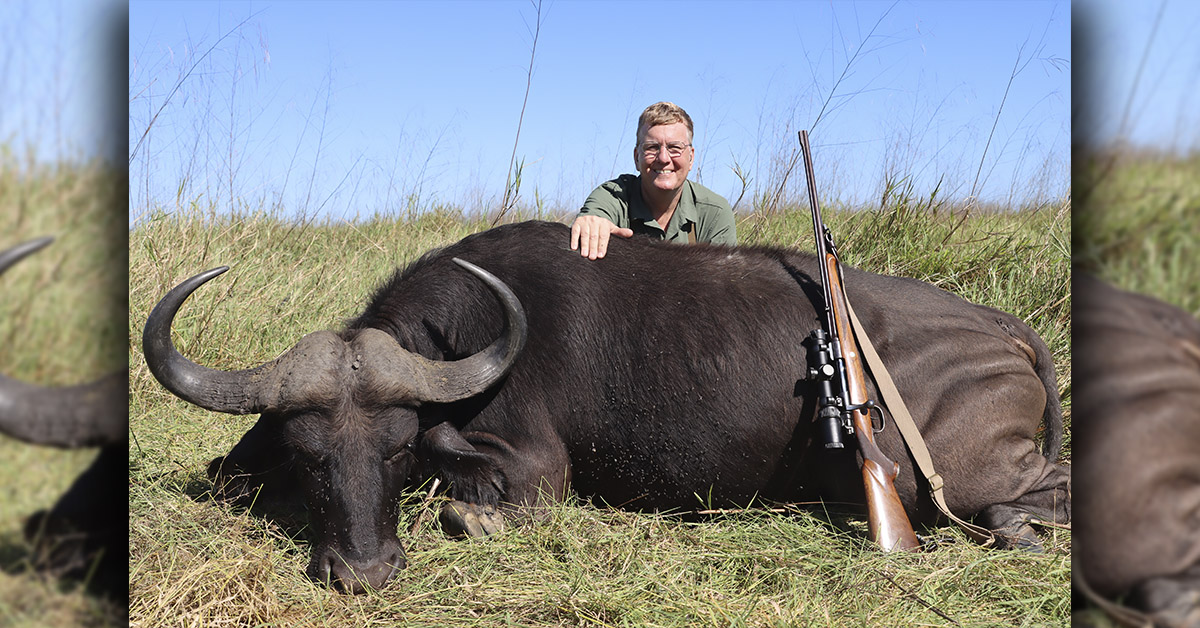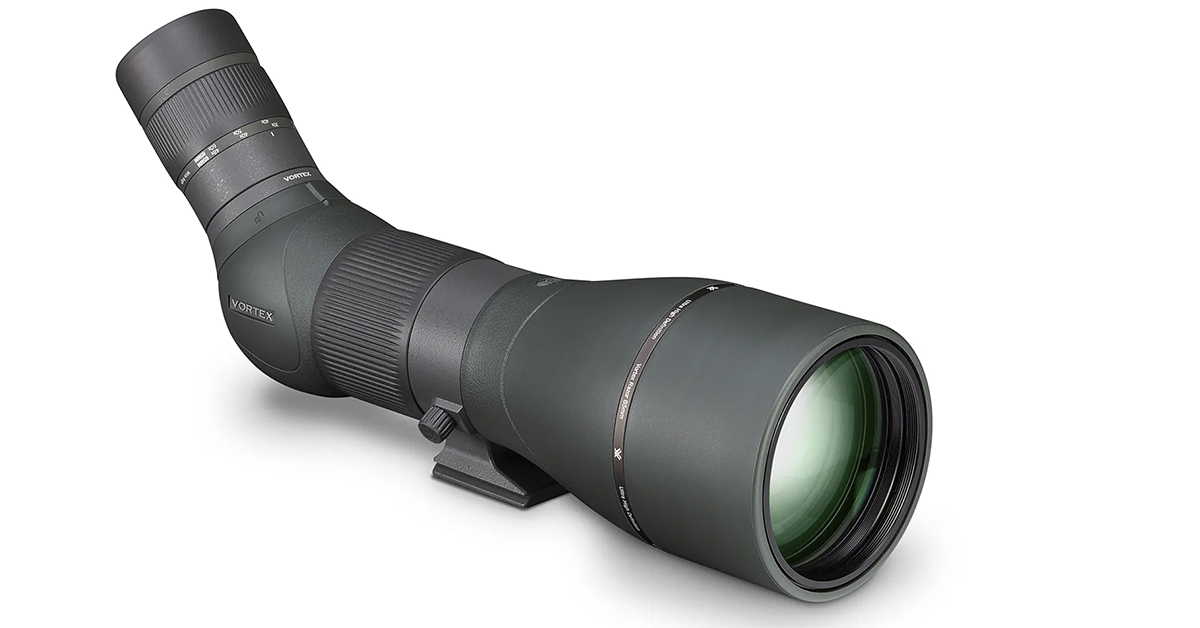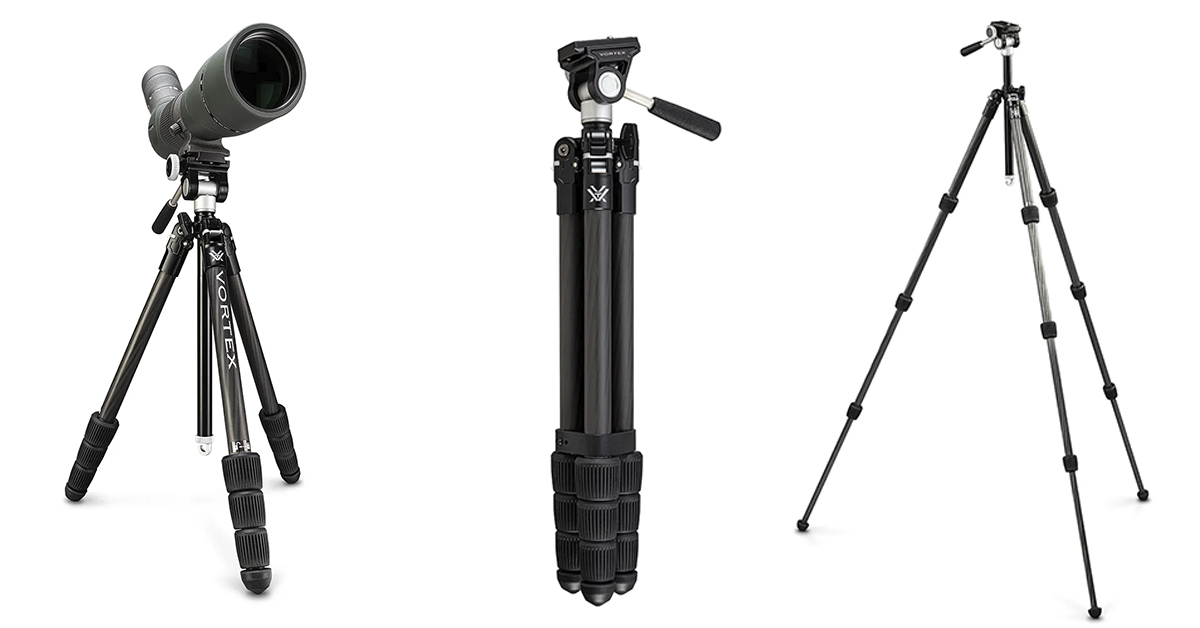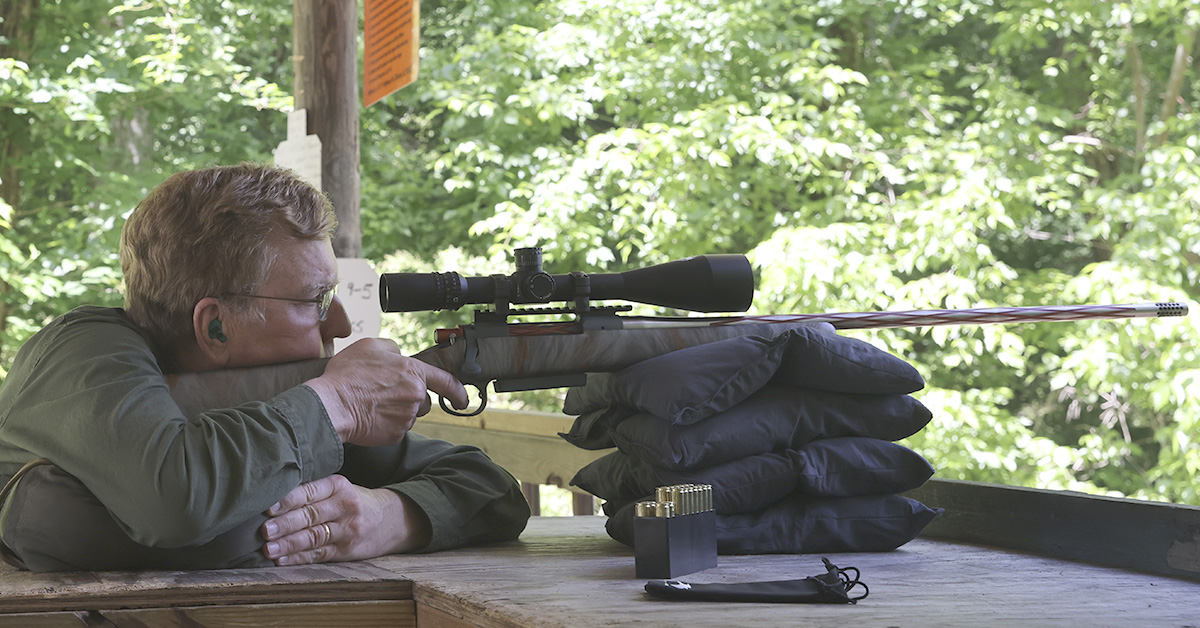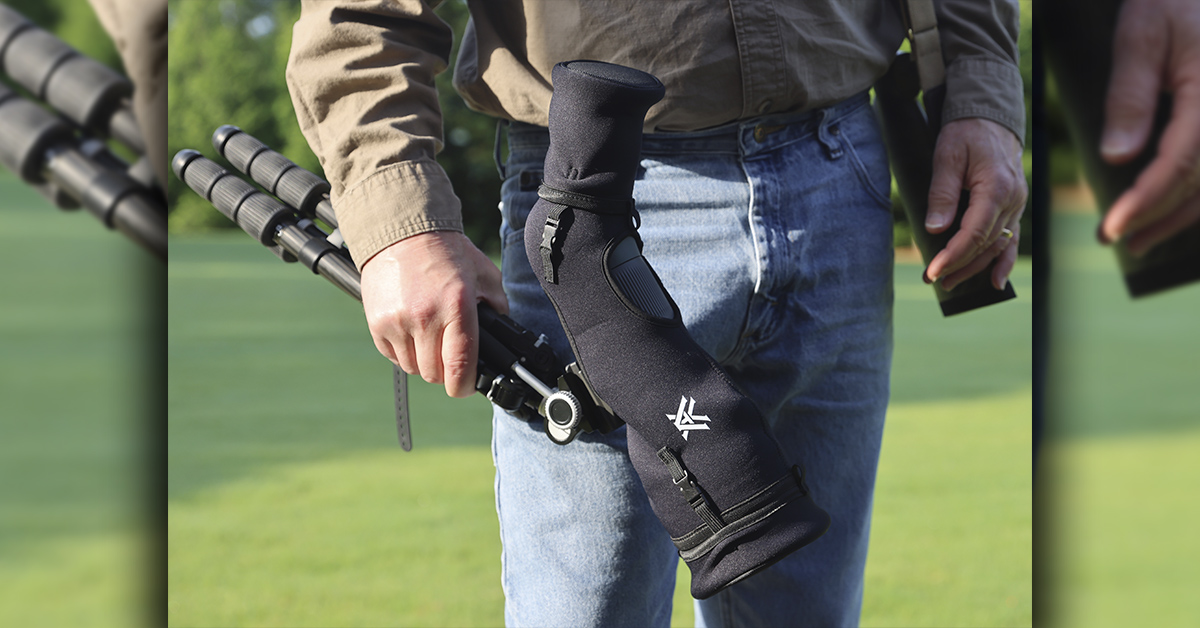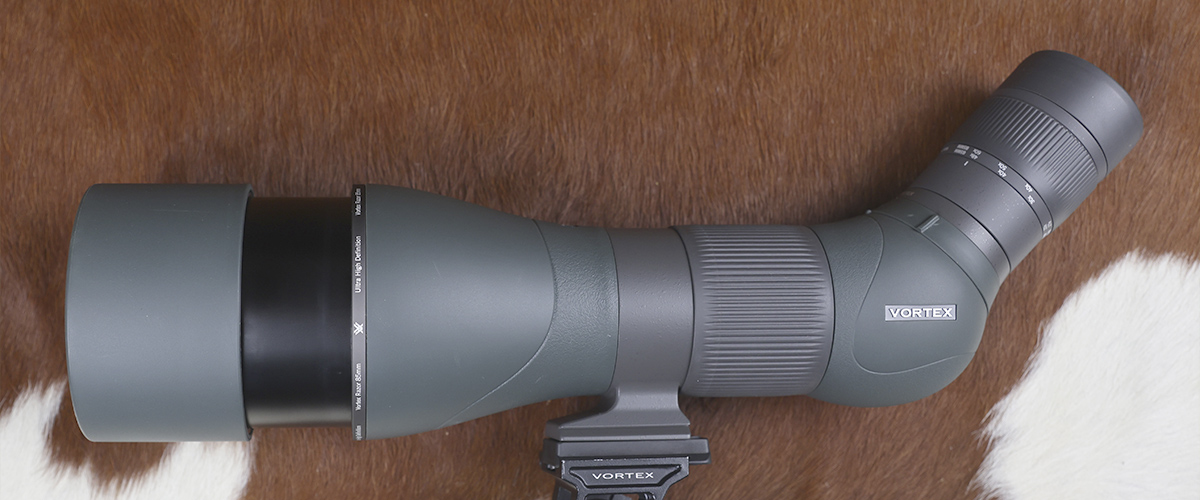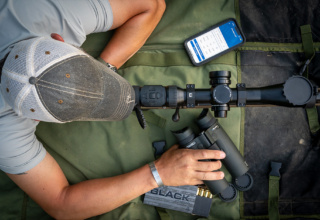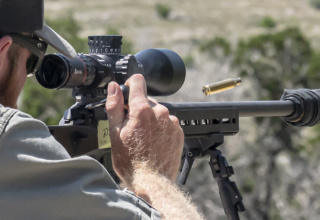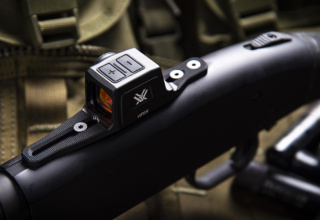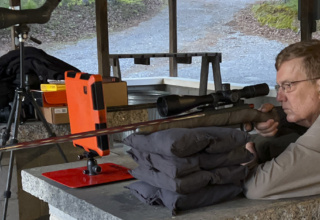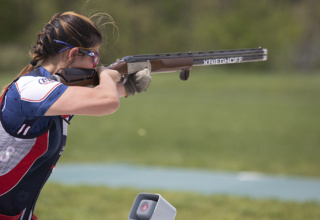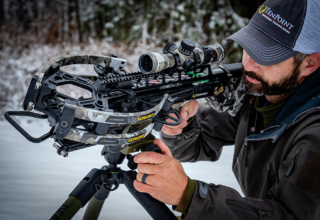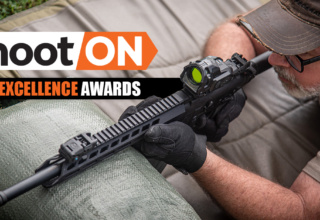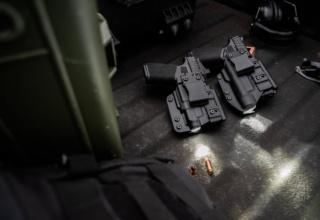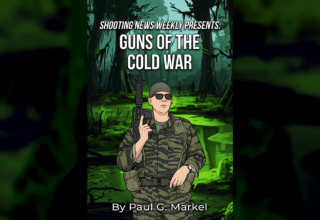If you need clear viewing way out there, Vortex’s Razor HD 27-60×85 Spotting Scope (Angled) and Summit Carbon II Tripod stand ready
by Mike Arnold
My first encounter with Vortex Optics occurred while attending the Precision Rifle with Elevated Shooting course at the Government Training Institute near Barnwell, South Carolina. The course demanded excellence from all the equipment used, including optics. We engaged targets located at 50 to 800 yards, and at elevations ranging from ground level to the top of a 10-floor building. Yep, really outstanding training for angled, long-distance shooting.
But back to the Vortex optics.
Standing on top of the 10-floor building, calling impacts for my shooting partner at targets out to 800-yards away, proved the clarity and adjustability of the Vortex spotting scope provided by our instructors. It was especially cool when I watched the bullet vapor through the optics as it curved across the cold, South Carolina landscape like the trail of a high-altitude jet.
Fast forward about 12 months and I found myself hunting Cape Buffalo in a swamp in Mozambique with Zambeze Delta Safaris. I carried a rifle chambered to .35 Whelen Improved topped with the tough Vortex Strike Eagle riflescope and a Vortex Fury HD Laser Rangefinder Binocular harnessed to my chest. As usual, clarity of the Vortex optics was excellent.
“My” bull stood at a mere 60 yards and the Strike Eagle’s illuminated reticle allowed a perfect aim point. The result was one shot and one dead buffalo. To put it simply, I found the quality of Vortex products excellent.
So, when Kerry O’Day of MG Arms recently asked me for a review of their Long-Range prototype rifle, I knew it was an opportunity to also review another Vortex spotting scope. For the rifle review, I would shoot at ranges from 100 yards to one mile. This would represent a tough test for shooter, rifle, and spotting scope. The spotting scope would need crystal clear glass and quick adjustability at my home range where I would shoot at “only” 100-400 yards. It would also need to provide excellent magnification at Clinton House Plantation’s long-range course; shooting would begin at 300 yards, moving to 500, 1000, and finally the 1760 yard mark.
For this long-range test session, I contacted Vortex and Sawyer Briel, the company’s Brand and Communications Manager, suggested I use their Razor HD 27-60×85 Spotting Scope (Angled) and Summit Carbon II lightweight tripod.
I want to start with the Summit tripod. Easy setup, straightforward attachment to spotting scopes or truck windows, quick adjustments for leg height or angle, tilt/panning, and center column height adjustment make this a great base for the Razor spotting scope. In addition to the mechanical attributes, the carbon construction means that the Summit weighs in at a mere 2.5 pounds. When a hunter needs a tripod for glassing, especially on trips involving carrying a pack, I can’t think of a better choice than the Summit Carbon II. The only cautionary note is that when we fully extended the legs and central column at the range, we needed to rest our hand on top of the four-pound Razor to provide stability for clarity. When the legs and/or column were lower, there was no issue with steadiness.
The first test with the Razor and Summit occurred at the Elbert County Gun Club’s 100- to 400-yard range. Arriving pre-dawn for setup, the sun rose on dense fog, with the 200- to 400-yard targets invisible. Shooting at the 100-yard target was possible, with impacts easily seen in the Razor’s field of view, thus allowing sight adjustment. The fog burned off slowly, with the 200-, 300-, and 400-yard targets eventually becoming visible. As with the 100-yard distance, the Razor allowed shot calls before the fog completely cleared at each distance.
The clarity and magnification of the Razor also allowed an estimate of MOA at each distance. This is particularly important when I am reviewing not only a firearm, but also determining which of several multiple types of ammunition is most accurate for an upcoming hunt. Not having to ask other shooters to ‘go cold’ while I run down to check targets is always preferable. The access to such great optics also shortens my range time when I can focus my shooting on the most accurate load before putting ruler to target. This may seem like a trivial benefit, but in this busy world, it isn’t. With the data gathered for accuracy of the MG Arms LR rifle and the first trial of the Razor and Summit combination completed, it was time to move to the long-range course at Clinton House Plantation.
In our Shoot ON review of the MG Arms LR rifle, I mentioned Kerry O’Day doubting their prototype’s capability of reaching the mile target. If I did set off the LED lights attached to the upright steel rectangle at 1760 yards, my spotter would need very clear optics to have any chance of seeing the impact. Furthermore, calling impacts and misses at 500 and 1000 yards as I worked my way up to the mile target would also require excellent clarity.
The day of the mile attempt dawned with full sun — great that rain or fog wouldn’t be a problem, but bad with the temperature being in the mid-80s and accompanying humidity nearing 80%. By shooting time, the heat waves and humidity-haze were making their presence felt and seen from the closest target at 300 yards to the nearly invisible steel plate at 1760 yards. In the plus column, this represented a great test for the Razor and Summit. We could report whether the optics were able to penetrate the waves and haze, allowing accurate calls when targets were at distances requiring three to six seconds for the sound of an impact to reach our ears.
Beginning at the 300-yard mark — the zero setting for my Kestrel Ballistics Meter — the rifle and spotting scope worked perfectly, with impacts and the calls from my spotter (wife, Frances) coming in quick succession. The next stage, following elevation changes calculated from the Kestrel computer, was the silhouette at 500 yards. It took a few windage adjustments when the first shot drifted off the right side. The Razor apparently gave the spotter a perfect view, with the call being “adjust one MOA left.” The next four shots made the metal ring.
We then made a big jump to the 1000-yard target. Again, following the needed elevational clicks and magnification changes to the riflescope, I squeezed off the first shot. “Low and center” was the call. Four of the next five shots stayed on the metal, with the third drifting to the left when I did not wait for a right-to-left wind gust to die down. Again, the calls from Frances for each hit came before the sound of the impacts reached the elevated shooting stand. Now for the real challenge of hitting the target 760 yards further on.
The humidity and haze had lessened as the sun headed to its zenith, causing a rapid increase in temperature. The heatwaves were, though, making their presence more apparent, at least through the rifle’s scope. My spotter/wife focused on the mile target, with its white background and orange bull, and smiled with the fact that she was able to see the steel better than the shooter. Having run out of elevational MOAs on the riflescope, it took a bit of work, including many “miss” calls, as we used a pine tree (and its branches) behind the target for adjustments. After some 10 shots, I adjusted a bit more and squeezed off another round. Approximately two seconds later Frances saw the LED lights illuminate, calling out the hit. It took another five seconds for the barely audible sound of the impact to reach my electronic earplugs. By the time I heard the faint tink, I was grinning from ear to ear.
Hitting the mile target completed the review of the rifle, Vortex Razor HD 27-60×85 Spotting Scope (Angled), and Summit Carbon II tripod. The combination of spotting scope and tripod worked excellently, allowing impact calls and MOA estimates at ranges from 100 yards to one mile and under environmental conditions ranging from decent to tough.
For anyone requiring a spotting scope and tripod for any or all the applications and conditions discussed here, the Razor plus Summit would be an excellent combination.
Razor HD 27-60×85 Spotting Scope (Angled) Specifications
- Magnification: 27-60x
- Objective Lens Diameter: 85 mm
- Linear Field of View: 117-68 ft/1000 yds
- Angular Field of View: 2.2-1.3 degrees
- Eye Relief: 16.7-17 mm
- Length: 15.5 inches
- Weight: 65.6 oz
- Close Focus: 16.4 feet
- Waterproof: yes
- Fog proof: yes
- Shockproof: Yes
- Tripod Adaptable: allowing use on a tripod or car window mount.
- Neoprene Slip-on Cover: yes
- MSRP: $2399.99
Summit Carbon II Tripod Specifications
- Weight: 2.5 pounds
- Head Mount: Arca-Swiss
- Minimum Height: 6.3 inches
- Maximum Load: 22 pounds
- Maximum Height: 53.3 inches
- Leg Sections: 4
- Leg Angles: 80°, 52°, or 24° (using leg angle pivot lock)
- Leg Locks: 1/4 turn
- Leg Material: carbon fiber
- Folded Dimensions (HxW): 18.1 x 3.0 inches
- MSRP: $549.99
- TESTED: Vortex Razor HD Spotting Scope…Clarity for the Distance - July 24, 2024
- Shooting for the Mile! - June 19, 2024
- Instinctive and Relaxed - May 22, 2024

